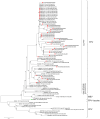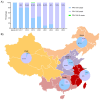Epidemiological and Molecular Investigation of Feline Panleukopenia Virus Infection in China
- PMID: 39772273
- PMCID: PMC11728606
- DOI: 10.3390/v16121967
Epidemiological and Molecular Investigation of Feline Panleukopenia Virus Infection in China
Abstract
The feline panleukopenia virus (FPV) is a highly contagious virus that affects cats worldwide, characterized by leukopenia, high temperature and diarrhea. Recently, the continuous prevalence and variation of FPV have attracted widespread concern. The aim of this study was to investigate the isolation, genetic evolution, molecular characterization and epidemiological analysis of FPV strains among cats and dogs in China from 2019 to 2024. The 41 FPV strains, including 38 feline strains and 3 canine strains, were isolated from rectal swab samples by inoculating monolayer FK81 cells and performing a plaque purification assay. The viral and hemagglutination titers of these 41 FPV strains were 104.33~106.33 TCID50/0.1 mL and 7.0 log2~9.7 log2, respectively. Based on the complete VP2 gene, the nucleotide homology of these FPV strains was 98.91~100%, and the homology with 24 reference FPV strains from different countries and hosts was 98.85~100%. The phylogenetic analysis revealed that 41 FPV strains were more closely related to the FPV strains of Asian origin (Asian FPV strain group) than those of European and American origin (European and American FPV strain group). Furthermore, 12 mutation sites of the VP2 protein were found in these FPV strains, of which 91 and 232 amino acid sites were previously reported. Moreover, the 91 amino acid site was found to be a positive selection site with the highest dN/dS value in the selection pressure analysis. Importantly, 35 FPV strains with 91S substitution in the VP2 protein (FPV-VP2-91S strains) had formed obvious evolutionary branches in the Asian FPV strain group. The analysis of all available VP2 protein sequences of Chinese FPV strains in the GenBank database showed that the occurrence rate of FPV-VP2-91S strains had been increasing from 15.63% to 100% during 2017~2024, indicating that the FPV-VP2-91S substitution in the VP2 protein was a noteworthy molecular characteristic of the dominant FPV strains in China. These results contribute to a better understanding of their genetic evolution and renew the knowledge of FPV molecular epidemiology.
Keywords: 91S substitution; VP2 gene; feline panleukopenia virus; genetic evolution; molecular characterization.
Conflict of interest statement
Author Jiankun Wang was employed by the company Nanjing Taihe Bioengineering Co., Ltd. The remaining authors declare that the research was conducted in the absence of any commercial or financial relationships that could be construed as a potential conflict of interest.
Figures



 ).
).
Similar articles
-
Feline Panleukopenia Virus ZZ202303 Strain: Molecular Characterization and Structural Implications of the VP2 Gene Phylogenetic Divergence.Int J Mol Sci. 2025 May 10;26(10):4573. doi: 10.3390/ijms26104573. Int J Mol Sci. 2025. PMID: 40429717 Free PMC article.
-
Molecular analysis of partial VP-2 gene amplified from rectal swab samples of diarrheic dogs in Pakistan confirms the circulation of canine parvovirus genetic variant CPV-2a and detects sequences of feline panleukopenia virus (FPV).Virol J. 2018 Mar 15;15(1):45. doi: 10.1186/s12985-018-0958-y. Virol J. 2018. PMID: 29544546 Free PMC article.
-
Genetic analysis of feline parvovirus reveals predominance of feline parvovirus-G1 group among cats in China.J Vet Med Sci. 2024 Sep 20;86(9):1032-1039. doi: 10.1292/jvms.24-0138. Epub 2024 Jul 15. J Vet Med Sci. 2024. PMID: 39010245 Free PMC article.
-
Feline panleukopenia virus: its interesting evolution and current problems in immunoprophylaxis against a serious pathogen.Vet Microbiol. 2013 Jul 26;165(1-2):29-32. doi: 10.1016/j.vetmic.2013.02.005. Epub 2013 Feb 18. Vet Microbiol. 2013. PMID: 23561891 Review.
-
Feline parvovirus infection and associated diseases.Vet J. 2014 Aug;201(2):150-5. doi: 10.1016/j.tvjl.2014.05.027. Epub 2014 May 22. Vet J. 2014. PMID: 24923754 Review.
Cited by
-
Elucidating the Microsatellite Signature of the Tri-Partite Genomes of the Viral Family Peribunyaviridae.Curr Microbiol. 2025 Mar 13;82(5):191. doi: 10.1007/s00284-025-04177-2. Curr Microbiol. 2025. PMID: 40080168
-
Feline Panleukopenia Virus ZZ202303 Strain: Molecular Characterization and Structural Implications of the VP2 Gene Phylogenetic Divergence.Int J Mol Sci. 2025 May 10;26(10):4573. doi: 10.3390/ijms26104573. Int J Mol Sci. 2025. PMID: 40429717 Free PMC article.
References
Publication types
MeSH terms
Substances
Grants and funding
LinkOut - more resources
Full Text Sources
Miscellaneous

